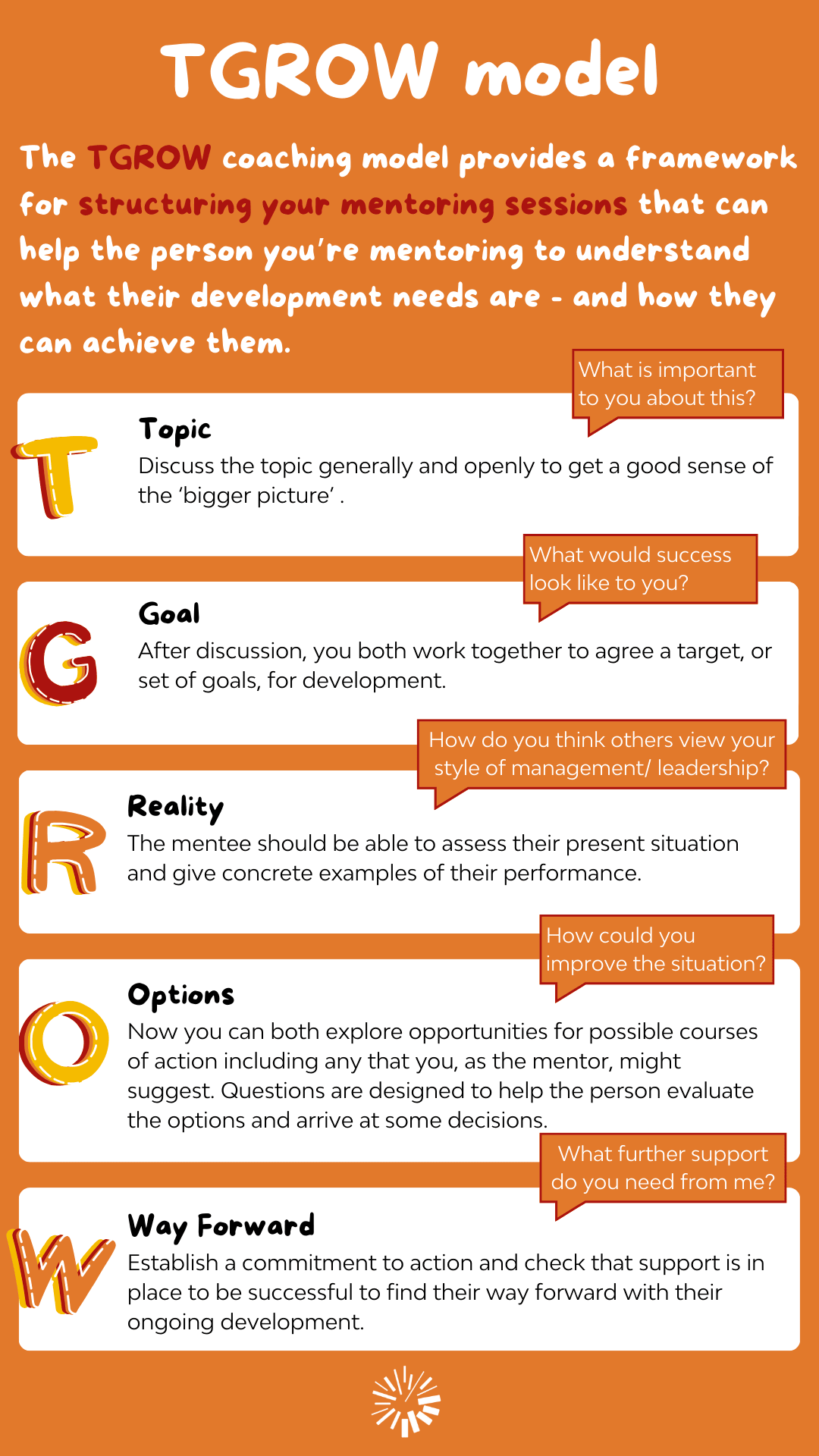The TGROW model
Listen to this article on the go.
When you are mentoring someone, your role is to help your mentees to discover and use their strengths and to unlock their potential. The TGROW coaching model provides a framework for structuring your mentoring sessions that can help the person you’re mentoring to understand what their development needs are - and how they can achieve them.
The TGROW model is based on two important principles:
-
Everyone has the potential to develop and improve themselves, but just need help to unlock their potential. Mentoring is the key to this.
-
Questions can be used to foster conversations and lead to a commitment to change.
The acronym TGROW stands for Topic, Goal, Reality, Options and Way Forward

How you can use TGROW in your mentoring sessions
TOPIC
The first part of the discussion conversation is exploratory. It enables you and your mentee to get a sense of the bigger picture. If it is your first session, you will also want to get a sense of how you are both going to work together, asking questions such as:
- How do you want your career to progress?
- What is important to you about this?
- What areas of your development do you want to address?
- What is behind this?
- What would this mean to you?
- What outcome do you want from this process?
- How do you feel this mentoring process will help you?
- What would you like to talk about in this session?
Top Tip:
Keep an open mind. Be ready to adapt your session to work with what comes up in this conversation. The discussion may uncover new priorities that require you to re-focus the topic of the session.
GOAL
After the initial discussion, you both work together to agree a target, or set of goals, for development, asking questions such as:
- What do you want to achieve?
- By when?
- What would success look like?
- If it is your first session, you also want to get some goals in place for how you will work together, so you might ask, for example:
- What would it take for this mentoring process to be a success?
Top Tip:
Listen more than you talk. Encourage and support the mentee to aim high.
REALITY
It is important that the session is grounded in reality. The person should be able to assess their present situation and give concrete examples of their performance. Help them by asking:
- How do you see your style of management/leadership?
- How do you think others view your style of management/ leadership?
- What are your strengths?
- Can you provide examples of when you are using them?
- How can you do more of this?
Top Tip:
As you provide constructive feedback, remember to encourage building on the person’s strengths rather than focussing on things the person does not do so well.
OPTIONS
Now you can both explore opportunities for possible courses of action including any that you, as the mentor, might suggest to focus on.
The following questions are designed to help the person evaluate the options and arrive at some decisions:
- How could the situation change?
- How could you improve the situation?
- How can you use your signature strengths to help you?
- Can you provide some specific options for action?
- Are you aware of the possible downsides to those options?
- Which of these suggested options would you like to try?
Top Tip:
Keep listening! Don’t think you know what the answer is – your mentee might surprise you!
WAY FORWARD
The final stage is about achieving a commitment to a set of actions and to check that the person has the support in place to be successful to find their way forward with their ongoing development. Questions you might ask include:
- How can you put these options into action?
- Are you aware of any obstacles to these actions?
- How will you continue to build on your strengths?
- What further support do you need from me?
- Does your organisation offer in-house support for change?
- If not, can you push for an in-house support system?
- Can you put this action plan into writing?
Top Tip:
Keep the focus on what the mentee has said they want to achieve. The aim is to help your mentee develop their own action plan, not go down a pre-determined path.
Further resources and reading
IoEYE Article: What is Mentoring in the Early Years
IoEYE - 10 Ways a Mentor Can Help You - Infographic
IoEYE - BOOST your feedback - Infographic






